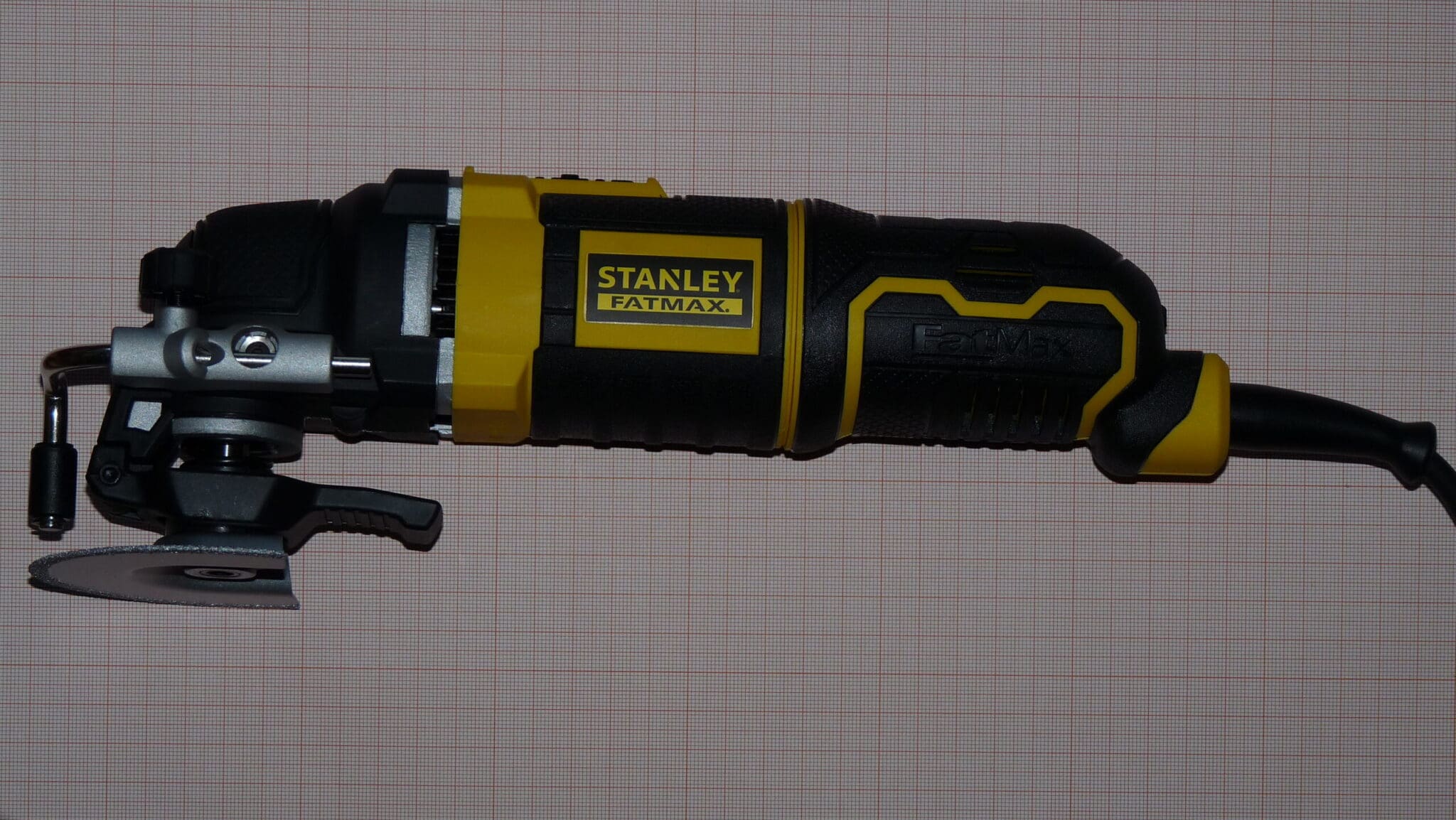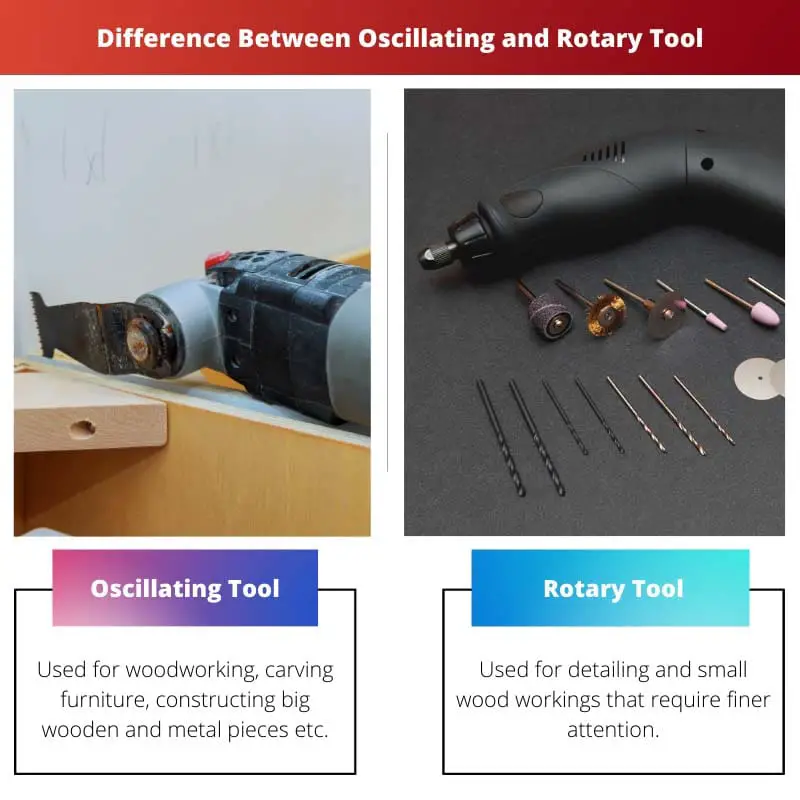For a job, a conventional teardown specialist or artisan will have a range of tools.
While hand-held power tools may make up the bulk of the equipment used in a wide range of home renovation and trivial tasks, it’s vital to remember that tools come in a variety of shapes and sizes.
It’s critical to realize that different tools might be utilized for the same task. While some tools are more effective than others, some are just safer and more efficient than others.
As a result, the goal of this article is to compare two widely used craftsman tools, an oscillatory tool and a rotary tool, side by side in order to highlight their USPs and differences for simplicity of use and specific applications.
Key Takeaways
- Oscillating tools use a side-to-side motion for cutting, sanding, and grinding.
- Rotary tools use a high-speed spinning motion for similar tasks.
- Oscillating tools provide more control and precision, while rotary tools offer more power and versatility.
Oscillating Tool vs Rotary Tool
In woodworking and crafts, an oscillating tool is a strong blade that moves in a to and fro motion and is used for carving furniture and big wood. A rotary tool is a hand-held tool used for small detailing in woodwork. It is a compact tool specifically designed for craftsmen for home improvement.

An oscillating tool was initially developed for architecture and home repair activities, but because of its precise accuracy and ability to operate in small areas, it has grown in popularity as a renowned woodworking and crafts equipment over time.
With the right accessories, it can carve, polish, mould, gouge and grind nearly anything.
The foundation of the original was developed by Fein Multimaster (a German firm founded in 1967 to remove plaster casts without hurting the patient) and is the culmination of more than 50 years of experience and a creative spirit.
Fein invented the oscillating power tool – and hence the first Mul-tiTool for professionals – in 1967.
Dremel began in 1932 with the release of the very first rotary tool by A.J. Dremel, the firm’s creator. A rotary tool features a hopper that accepts a variety of bits and a compact, robust, rising motor.
A rotary tool, unlike a chisel-drilling machine, is intended to withstand sideways pressures on the bit. While you’ll be capable of keeping it in your hands and determining its precision, rotary tools are recognized for being quite accurate.
Comparison Table
| Parameters of Comparison | Oscillating Tool | Rotary Tool |
|---|---|---|
| Pioneer Maker | The first oscillating power tool was launched by FEIN MULTIMASTER; a German manufacturer, in 1967. | The first rotary tool was launched by Dremel and co. in 1932. |
| Functioning | An oscillating tool produces thousands of revolutions every minute, and it’s buzzing head spins 3 degrees fro and back, making it one of the fastest and safest power tools on the market. | A rotary tool features a hopper that accepts a multitude of bits and a compact, efficient, elevated motor. |
| Purpose | Used for woodworking, carving furniture, constructing big wooden and metal pieces etc. It can also be used for polishing wooden materials. | Used for detailings and small woodworkings that require finer attention. Used by craftsmen rather than carpenters. |
| Attachments | Sanders, scrappers, blades, grinders and rasps. | Etching bits, router drills, cutting bits, milling bits, and sanding drums. |
| Power Options and size | It is big in size and has both corded and battery fueled power options. | It is smaller and compact than an oscillating tool and has both the power sources as in cord and battery. |
What is an Oscillating Tool?
An oscillating tool may be quite beneficial for several tasks.
The very first thing to realize is that an oscillation tool may be considerably more useful than a rotary tool for big manufacturing tasks simply because it is intended to make big projects considerably quick and easy to execute.
FEIN MULTIMASTER launched the first oscillating power tool; a German manufacturer, in 1967.
Unlike a rotary tool, which rotates fast, oscillating tools are intended to move backwards and forth quickly.
Despite their variations in appearance, the two instruments are capable of performing the majority of the same tasks. For polishing, scraping, and cutting bigger bits of wood, an oscillating tool may be preferable.
One of the most significant benefits of utilizing an oscillating tool for complex projects is the major drop in dust generation.
That’s because the connections are larger than the fasteners on a rotary tool, making it simpler for them to operate into materials.
The more quickly the item must move, the more dust it will create.
An oscillating tool is much more useful with first workers or rookies in the carpentry business in terms of size and ease of making straight cuts, as well as how efficient it would be to smoothen big materials.
Considering that these tools were created to handle huge tasks, they are excellent for novices.

What is a Rotary Tool?
A rotary tool may perform a broad range of tasks, like polishing, scraping, and sawing tiles and other surfaces.
A location for an extension or auxiliary, including a polishing or sandpaper bit, will be located at the user’s tip, and this component will spin extremely rapidly.
Because you’ll be capable of holding it in your hands and determining its precision, rotary tools are recognized as being quite accurate.
The first rotary tool was launched by Dremel and Co. in 1932. When used correctly along with attachments, a rotational tool may be utilized for a wide variety of functions, including cleaning, sawing, polishing, shaping, polishing, and smoothing.
A rotary tool is considerably more developed than an oscillating tool since it can handle many more jobs. A rotary tool can polish, shine, router, and carve a broad range of materials, in addition to the functions that the two instruments share.
A rotary tool is considerably more useful than an oscillating tool for fine, precise work like etching, even if it isn’t a process you’ll have to conduct regularly.
A rotary tool, with both creativity and the right connectors, can be incredibly helpful for all of your carving Home improvements.
Whenever in the grip of a specialist maintenance man or woodworker, are they recognized for their absolute accuracy? A rotary tool, in the proper hands, may be quite useful.
Main Differences Between Oscillating and Rotary Tool
- An oscillating tool is used for big woodworking and carvings, whereas a rotary tool is used for fine detailing and molding.
- The oscillating tool was first launched in 1967, but the rotary tool was launched in 1932.
- An oscillating tool is a powerful tool with multi-purpose usage, but the rotary tool is small-scale and required for selective work.
- The first oscillating tool was manufactured by Fein Multimaster, whereas the first rotary tool was manufactured by Dremel Industries.
- The oscillating tool is larger and bulkier than the handy and compact rotary tool.


A brilliant and well-researched piece on these essential tools. The comprehensive description of their functions and applications is impressive.
The detailed comparison table provides a quick and efficient way of understanding the main differences between oscillating and rotary tools. Very well done.
I couldn’t agree more. The comparison table is a standout feature of this article.
Absolutely, the comparison table is a valuable addition to the article.
I found this article extremely helpful and enlightening. The in-depth analysis of both tools has broadened my knowledge about their uses and features.
I appreciate the detailed explanations about how each tool functions and the historical background of their development. Very insightful.
This article is certainly thorough and informative.
Absolutely, the depth of information in this article is commendable.
I’m disappointed by the lack of real-world examples of applications for these tools. It’s a bit too theoretical for my taste.
This article neglects to discuss the potential downsides of both tools. While it provides a good comparison, it doesn’t delve into any negative aspects of using oscillating or rotary tools.
I understand your point, but perhaps the focus of the article was to highlight the specific benefits of each tool rather than dwell on the negatives.
That’s a valid point, but I think it’s important to present a balanced view of the tools, including their limitations.
The historical context about the origins of these tools is fascinating and adds an interesting dimension to the comparison.
Great article, the comparison between oscillating and rotary tools is very detailed and informative. It provides a clear understanding of the differences and usages of each tool.
I completely agree, this post is very well-explained and thorough.